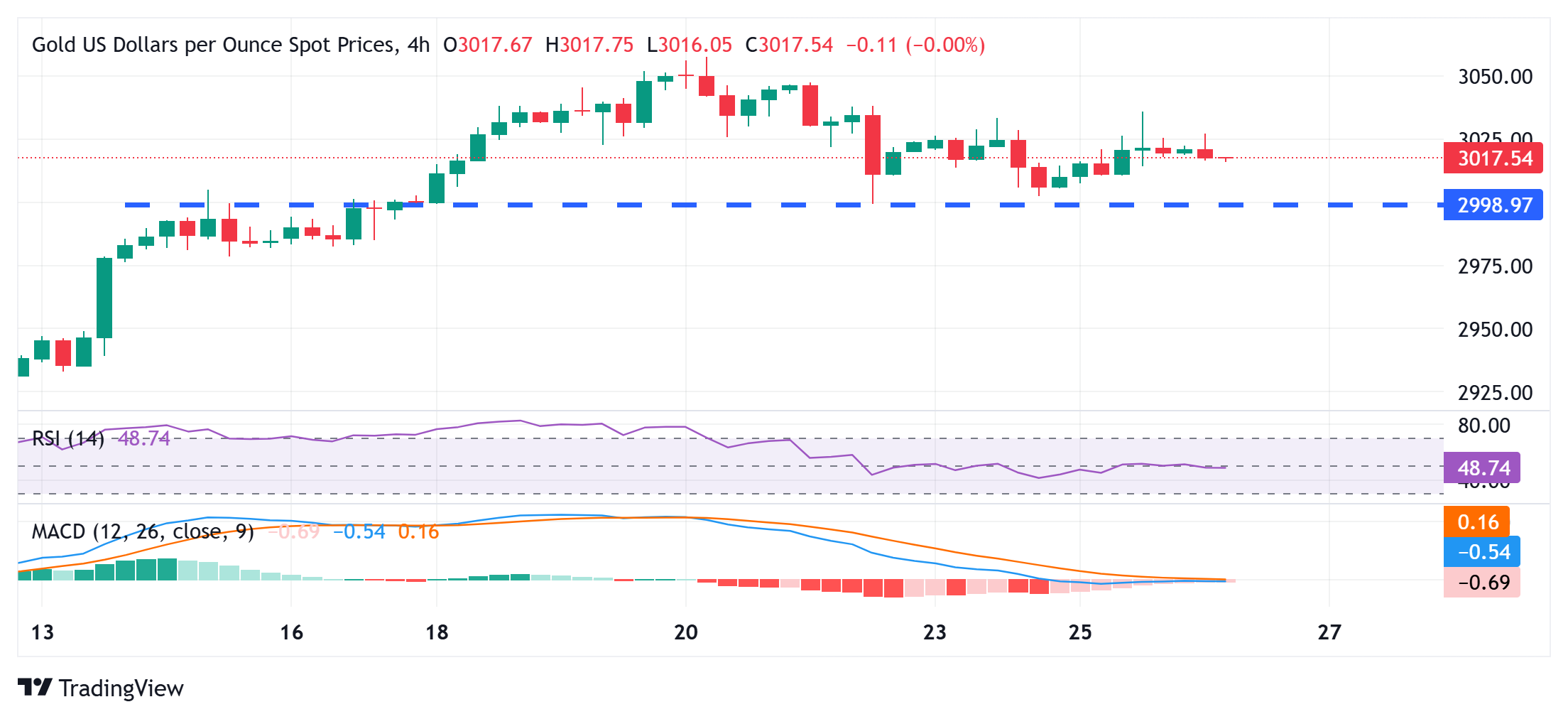- Gold price ticks lower on Wednesday amid some USD dip-buying.
- A positive risk tone further weighs on the safe-haven precious metal.
- Trade jitters, US recession fears, and Fed rate cut bets help limit losses.
Gold price (XAU/USD) struggles to capitalize on the previous day’s move higher and attracts some intraday sellers during the Asian session on Wednesday. The US Dollar (USD) regains positive traction and moves back closer to a nearly three-week high touched on Tuesday. This, along with a generally positive tone around the equity markets, acts as a headwind for the safe-haven precious metal.
However, the uncertainty over US President Donald Trump’s so-called reciprocal tariff plans for next week assists the Gold price to hold above the $3,000 psychological mark. Apart from this, bets the Federal Reserve (Fed) will resume its rate-cutting cycle soon, amid fears of a US recession, might hold back traders from placing aggressive bearish bets around the non-yielding yellow metal.
Daily Digest Market Movers: Gold price traders seem non-committed amid mixed fundamental cues
- The US Dollar retreated from a nearly three-week high after data released on Tuesday showed that the Conference Board’s US Consumer Confidence Index fell for a fourth straight month, to a four-year low level of 92.9 in March. The survey also revealed that the Expectations Index fell to 65.2, or the lowest level in 12 years and well below the threshold of 80 which usually signals a recession ahead.
- This comes after the Federal Reserve last week revised its growth outlook downward amid the uncertainty over the impact of US President Donald Trump’s trade policies. Moreover, reports that US reciprocal tariffs scheduled to be imposed on April 2 would be more targeted help ease inflation concerns and should allow the US central bank to keep cutting rates, benefiting the non-yielding Gold price.
- In fact, the Fed had signaled that it would deliver two 25 basis points interest rate cuts by the end of this year. The markets, however, are pricing in the possibility that the US central bank would lower borrowing costs in June, July, and October policy meetings. This overshadows hawkish remarks from Fed Governor Kugler, saying that she supports holding interest rates steady for some time.
- Meanwhile, Trump imposed a secondary tariff on Venezuela and said that any country that buys oil or gas from Venezuela would face a 25% tariff when trading with the US. Furthermore, Trump is expected to announce so-called retaliatory tariffs – that would offset levies on US goods and are set to take effect on April 2 – on about 15 major US trading partners, keeping investors on the edge.
- Russia and Ukraine have reached an agreement to halt military strikes in the Black Sea and on energy infrastructure following negotiations mediated by the US. Apart from this, the latest optimism over China’s stimulus aimed at boosting consumption remains supportive of a generally positive tone around the equity markets. This is holding back the XAU/USD bulls from placing aggressive bets.
- Traders now look forward to Wednesday’s release of US Durable Goods Orders, which, along with speeches by influential FOMC members, should provide some impetus to the USD and the commodity. The focus, however, will remain glued to the US Personal Consumption Expenditure (PCE) Price Index, which could provide cues about the Fed’s rate-cut path and drive the precious metal.
Gold price could appreciate further while above the $3,000 psychological mark pivotal support
From a technical perspective, bullish resilience near the $3,000 mark and the subsequent move up, along with positive oscillators on the daily chart, suggest that the path of least resistance for the Gold price is to the upside. Some follow-through buying beyond the overnight swing high, around the $3,036 area, will reaffirm the constructive outlook and lift the XAU/USD pair towards the all-time peak, around the $3,057-3,058 zone touched last week.
On the flip side, the $3,000 mark should continue to protect the immediate downside for the Gold price and act as a key pivotal point. A convincing break below might prompt some technical selling and drag the XAU/USD pair to the $2,982-2,978 region. The corrective fall could extend further toward the next relevant support near the $2,956-2,954 resistance breakpoint.
Risk sentiment FAQs
In the world of financial jargon the two widely used terms “risk-on” and “risk off” refer to the level of risk that investors are willing to stomach during the period referenced. In a “risk-on” market, investors are optimistic about the future and more willing to buy risky assets. In a “risk-off” market investors start to ‘play it safe’ because they are worried about the future, and therefore buy less risky assets that are more certain of bringing a return, even if it is relatively modest.
Typically, during periods of “risk-on”, stock markets will rise, most commodities – except Gold – will also gain in value, since they benefit from a positive growth outlook. The currencies of nations that are heavy commodity exporters strengthen because of increased demand, and Cryptocurrencies rise. In a “risk-off” market, Bonds go up – especially major government Bonds – Gold shines, and safe-haven currencies such as the Japanese Yen, Swiss Franc and US Dollar all benefit.
The Australian Dollar (AUD), the Canadian Dollar (CAD), the New Zealand Dollar (NZD) and minor FX like the Ruble (RUB) and the South African Rand (ZAR), all tend to rise in markets that are “risk-on”. This is because the economies of these currencies are heavily reliant on commodity exports for growth, and commodities tend to rise in price during risk-on periods. This is because investors foresee greater demand for raw materials in the future due to heightened economic activity.
The major currencies that tend to rise during periods of “risk-off” are the US Dollar (USD), the Japanese Yen (JPY) and the Swiss Franc (CHF). The US Dollar, because it is the world’s reserve currency, and because in times of crisis investors buy US government debt, which is seen as safe because the largest economy in the world is unlikely to default. The Yen, from increased demand for Japanese government bonds, because a high proportion are held by domestic investors who are unlikely to dump them – even in a crisis. The Swiss Franc, because strict Swiss banking laws offer investors enhanced capital protection.


